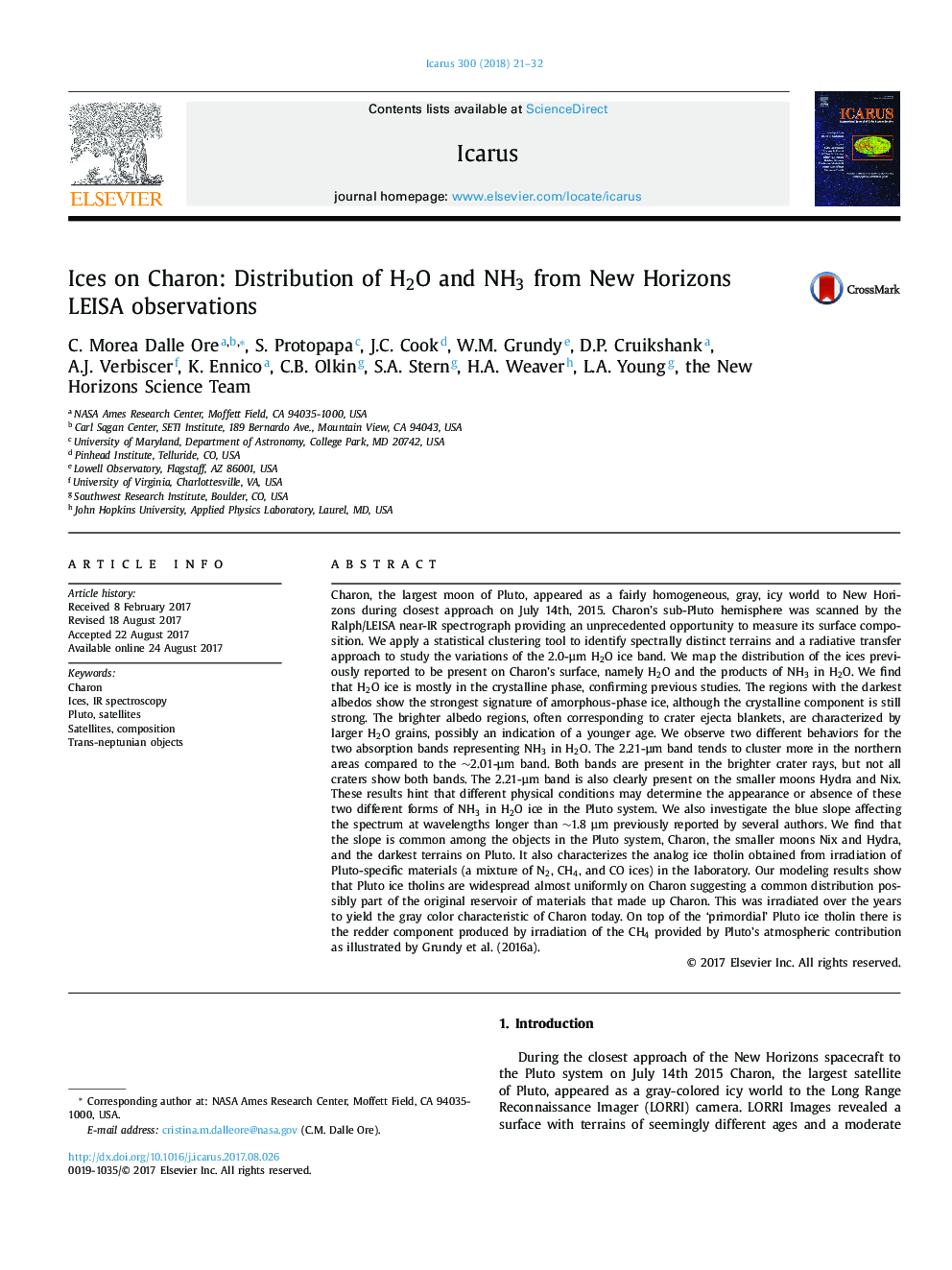| کد مقاله | کد نشریه | سال انتشار | مقاله انگلیسی | نسخه تمام متن |
|---|---|---|---|---|
| 5486934 | 1523491 | 2018 | 12 صفحه PDF | دانلود رایگان |
عنوان انگلیسی مقاله ISI
Ices on Charon: Distribution of H2O and NH3 from New Horizons LEISA observations
دانلود مقاله + سفارش ترجمه
دانلود مقاله ISI انگلیسی
رایگان برای ایرانیان
کلمات کلیدی
موضوعات مرتبط
مهندسی و علوم پایه
علوم زمین و سیارات
علوم فضا و نجوم
پیش نمایش صفحه اول مقاله

چکیده انگلیسی
Charon, the largest moon of Pluto, appeared as a fairly homogeneous, gray, icy world to New Horizons during closest approach on July 14th, 2015. Charon's sub-Pluto hemisphere was scanned by the Ralph/LEISA near-IR spectrograph providing an unprecedented opportunity to measure its surface composition. We apply a statistical clustering tool to identify spectrally distinct terrains and a radiative transfer approach to study the variations of the 2.0-µm H2O ice band. We map the distribution of the ices previously reported to be present on Charon's surface, namely H2O and the products of NH3 in H2O. We find that H2O ice is mostly in the crystalline phase, confirming previous studies. The regions with the darkest albedos show the strongest signature of amorphous-phase ice, although the crystalline component is still strong. The brighter albedo regions, often corresponding to crater ejecta blankets, are characterized by larger H2O grains, possibly an indication of a younger age. We observe two different behaviors for the two absorption bands representing NH3 in H2O. The 2.21-µm band tends to cluster more in the northern areas compared to the â¼2.01-µm band. Both bands are present in the brighter crater rays, but not all craters show both bands. The 2.21-µm band is also clearly present on the smaller moons Hydra and Nix. These results hint that different physical conditions may determine the appearance or absence of these two different forms of NH3 in H2O ice in the Pluto system. We also investigate the blue slope affecting the spectrum at wavelengths longer than â¼1.8 µm previously reported by several authors. We find that the slope is common among the objects in the Pluto system, Charon, the smaller moons Nix and Hydra, and the darkest terrains on Pluto. It also characterizes the analog ice tholin obtained from irradiation of Pluto-specific materials (a mixture of N2, CH4, and CO ices) in the laboratory. Our modeling results show that Pluto ice tholins are widespread almost uniformly on Charon suggesting a common distribution possibly part of the original reservoir of materials that made up Charon. This was irradiated over the years to yield the gray color characteristic of Charon today. On top of the 'primordial' Pluto ice tholin there is the redder component produced by irradiation of the CH4 provided by Pluto's atmospheric contribution as illustrated by Grundy et al. (2016a).
ناشر
Database: Elsevier - ScienceDirect (ساینس دایرکت)
Journal: Icarus - Volume 300, 15 January 2018, Pages 21-32
Journal: Icarus - Volume 300, 15 January 2018, Pages 21-32
نویسندگان
C. Morea Dalle Ore, S. Protopapa, J.C. Cook, W.M. Grundy, D.P. Cruikshank, A.J. Verbiscer, K. Ennico, C.B. Olkin, S.A. Stern, H.A. Weaver, L.A. Young, the New Horizons Science Team the New Horizons Science Team,